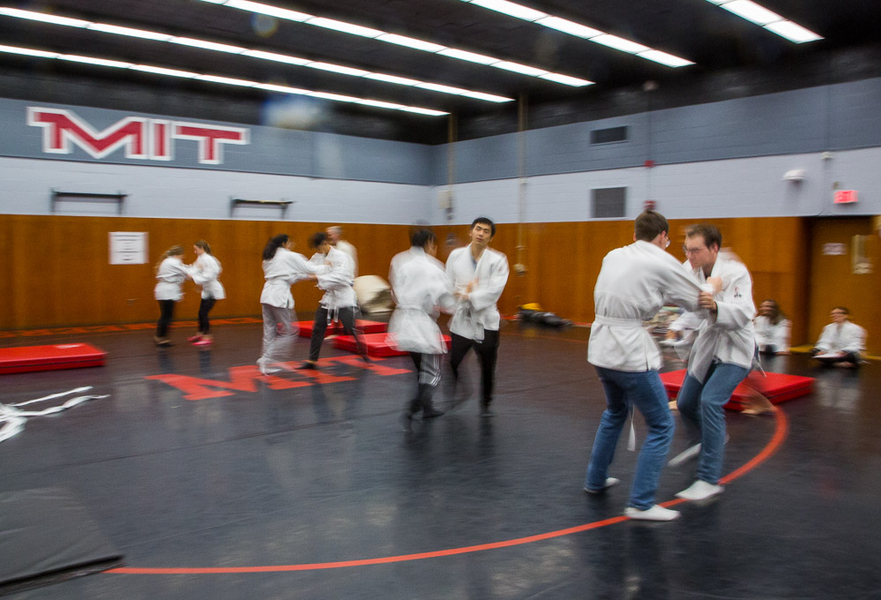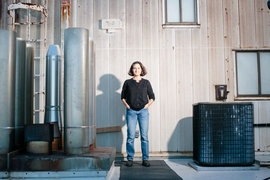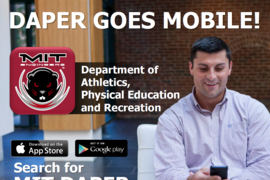It’s highly unusual for MIT students to be encouraged to throw one another to the floor, but that’s exactly what was happening during a lab that met in the Wrestling Room at the duPont Athletic Center at MIT in November.
After learning some basic judo moves and pairing off, students were instructed to shift their body weight and apply force all the way from their feet to their hands. “Your goal is to take your opponent down without hurting them,” explained Jennifer Light, the Bern Dibner Professor of the History of Science and Technology.
The session was just one meeting of many comprising Light’s experimental new course, STS.014 (Embodied Education: Past, Present, and Future). The premise of the class is that students think with both their brains and their bodies, and to explore how connecting academic subjects with movement could lead to stronger learning outcomes in K-12 education systems.
“It’s like we’re dancing,” laughed one student before gracefully pushing her partner backwards onto a soft mat. Thierry Lincou, head coach of the MIT Squash Team, who is also hoping to revive the school’s judo club, yelled, “The mat is your best friend,” demonstrating how to brace a fall by slapping the rubbery foam with one arm at a precise 45-degree angle.
At Light’s direction, he and the students had just finished reading “Fight Like a Physicist: The Incredible Science Behind Martial Arts,” by Jason Thalken — and it showed. As they were learning to take down their partners, they were also viscerally experiencing Newton’s laws of motion and other physics concepts.
Redefining classroom norms
Light said, “I want to expand campus conversations about the future of education beyond their present technology focus to incorporate the latest scientific research on movement and learning.”
On the first day of class, she shocked her students by turning a cartwheel mid-lecture. The deliberately transgressive act prompted them to question prevailing behavioral norms in the American classroom, where it’s often believed that children absorb information best when sitting stock-still.
MIT is one of the last prestigious institutions in the United States to hold onto a physical education requirement for undergraduates, probably due to its celebrated tradition of experiential learning. Students enrolled in Embodied Education receive both a humanities, arts, and social sciences (HASS) credit, and two physical education and wellness points.
With a nod to the MIT motto “mens et manus,” which translates to “mind and hand,” Light is asking her students, “What if learning is not just about mind and hand, but the whole body, too?” The hypothesis is backed by two fields of scientific research: exercise and cognition, and embodied cognition, which argue that there are measurable benefits to movement’s effect on learning.
Using history to invent the future
Although their focus is imagining educational futures, students look to the past for inspiration. Light is a historian of education, and her discipline provided the context for conversation. She explains, “Before there were school gyms, students regularly exercised in classrooms, and college gyms were once a hotbed of statistical and physiology research. But movement and academic learning eventually split.”
She points out that a new generation of scientific research suggests we rethink that relationship in the K-12 space. “That’s what I'm trying to do in this class. It's to tie together movement — as in judo — with specific academic content that the movement itself illustrates.”
The idea for the class dawned on Light after conversations with a high school physics teacher turned circus coach, who demonstrated the physics behind acrobatics and how to force test aerial silks. An avid athlete, she spent a sabbatical in circus school developing the curriculum.
Over the semester, the class has met for discussions on Tuesdays, while on Thursdays they’ve turned up in workout gear for participatory lab exercises that have tapped the tremendous offerings available at the Department of Athletics, Physical Education, and Recreation (DAPER).
MIT faculty and guest instructors have volunteered to lead the 10 students in sessions like “Yoga and Geometry: Math lessons that stretch both body and mind” (led by Lead Wellness Instructor Sarah Johnson), or “Hip Hop and Black Culture: Learning history by dancing it” (led by Music and Theater Arts Lecturer McKersin Previlus).
The playground as a classroom
Bent on questioning and testing his own assumptions and experiences in education, Thomas Ngo, a senior majoring in Course 6-9 (Computer Science and Cognitive Science), signed up for Embodied Education. He says, “In an academic setting we are told to just accept that a formula is true. But there are some students that are suspicious about why the formula really matters.” The goal of incorporating movement is to let students test concepts in real life in a more engaged way.
Ngo saw this firsthand when he and a classmate prepared their first assignment earlier in the fall, in which they were tasked with using a local playground as an interactive classroom and planning a lesson suitable for elementary school-aged students.
Staring up at the monkey bars, Ngo smiled as it dawned on him that the equipment name is meant to call to mind monkeys dangling by their arms and tails for an extended time — something he would ask the kids to try, too. “We can use that activity as a way to explain evolutionary biology,” he suggests. “Monkeys and humans share a common ancestor, and their bodies were designed to be similar. But at some point, humans and monkeys branched out. And you know, there's a reason why that happened, and we can show them the environmental factors.”
Learning on the move
In addition to covering the history of physical education, syllabus readings include the latest scientific studies on the impact of movement on learning — findings that would confirm that kids might remember an abstract concept like evolutionary biology much more effectively if they were challenged to hang on the monkey bars as long as a primate rather than just learning about evolution from a textbook at their desks.
Ceci Muñoz, a math major and student athlete on the soccer team, struggled to keep still in school as a kid and was sometimes “scolded” for fidgeting. After this class, she realizes that her instinct to wiggle while absorbing information was in fact a positive thing. She observes, “We’ve read a lot about how light-to-moderate activity and movement actually can enhance your thinking and encourage you to be more creative.”
Reflecting on her own high school experience, Muñoz realizes, “Introductory Physics was the only class where you combined movements and learning, and it was super helpful to have that demonstration and use your body to assist with comprehending what everything meant. I think if we can start to integrate that more into classes, it'd be beneficial.”
Light asked students to re-imagine a classic MIT assignment — the problem set — as an embodied activity. They created a math trail around campus with problems for one another to solve with physical activities, like estimating the area of non-standard shapes with just their feet.
What if physical education, a subject mandated in most states, was team-taught with STEM teachers in lessons just like this one?
Most elementary and middle schools have a square-dancing unit, and one Thursday lab imagined if the calls for dancing were also a way for kids to learn coding. Enter Tech Squares, the square and round dancing club of MIT.
After members of the club led the students in various dances — including one sung by microphone to a lesser-known Lady Gaga tune, Guy Steele Jr. PhD ’80, one of the callers and a computer scientist by day, delivered a lecture on square-dancing as a programming language.
“If the calls are the code, what are the data structures?” he asked. “The data structures are the formations. Callers think in terms of where the dancers are on the floor, and they look for the geometrical patterns,” he explained. Simultaneously, the foot tripping square-dancing calls and the concept of coding came into sharper focus to everyone.
Light is determined to teach this radical course again in 2023; hopefully, with the addition of opportunities for students to share their lessons with local schoolchildren.
It was with the support of MIT Director of Physical Education and Wellness Carrie Sampson Moore and her network that Light was able to loop in so many guest experts the first time she taught Embodied Education. For Light, connecting all these athletes, academics, and community members together was exciting: “It's been thrilling to bring together people from across the campus for a new kind of cross-disciplinary conversation.”









